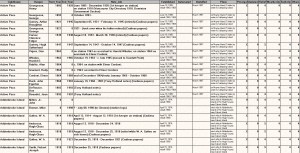 The following extracts taken from early Victoria, British Columbia (BC) newspapers are credited to Leona Taylor for her excellent work in indexing the papers. Full information can be found here: “Index of Historical Victoria Newspapers“, 2007-09.
The following extracts taken from early Victoria, British Columbia (BC) newspapers are credited to Leona Taylor for her excellent work in indexing the papers. Full information can be found here: “Index of Historical Victoria Newspapers“, 2007-09.
***********************************
Victoria Daily Times – Barkentine Skagit, of Port Gamble, struck the rocks near Clo-oose at 4am. There was a bad Southwest gale and a heavy sea, with fog, at the time.
Captain Rose was drowned, as was also the cook, name unknown. The vessel is a total loss. Mate Langkow and 7 men are ashore at Logan’s place.
Skagit, bound from San Francisco to Port Gamble, is ashore and liable to become a wreck on West Coast Vancouver Island. She sailed from the Bay City on Oct 13. Continue reading Lighthouse History – 27 (1906-10-25 to 1907-02-02)

 I am not a poet, or I should re-phrase that and say that I can write about lighthouses, but I cannot write poetry about lighthouses, so I went on the Internet and started looking.
I am not a poet, or I should re-phrase that and say that I can write about lighthouses, but I cannot write poetry about lighthouses, so I went on the Internet and started looking.





